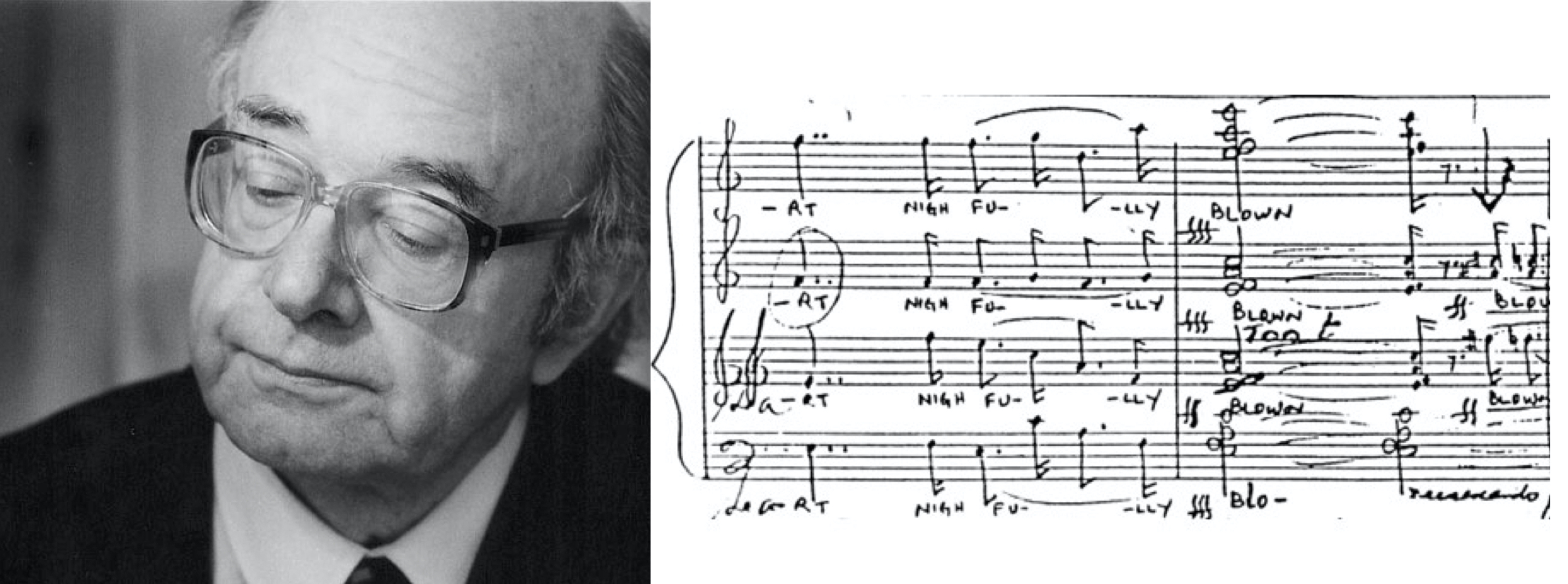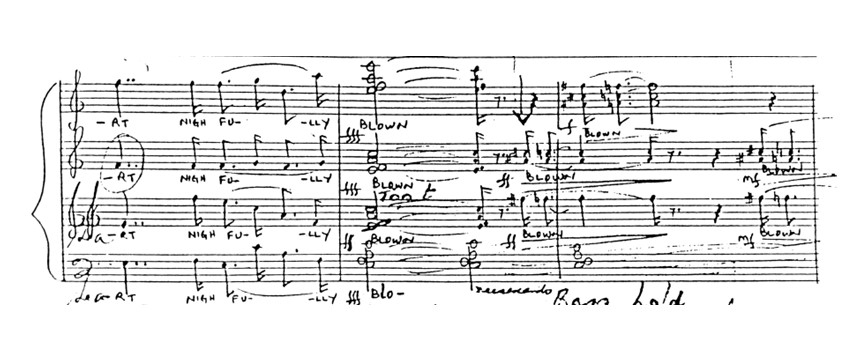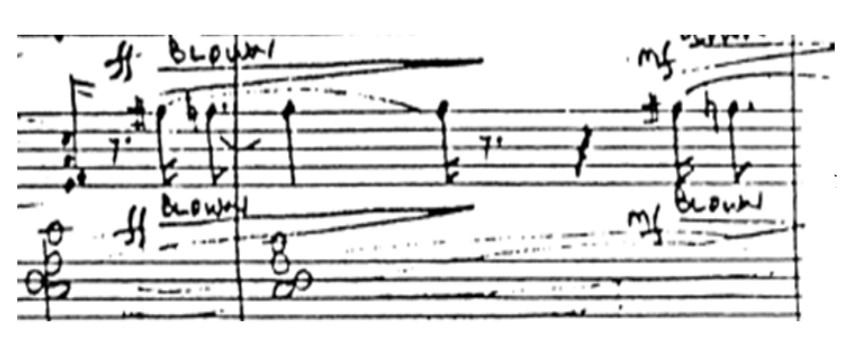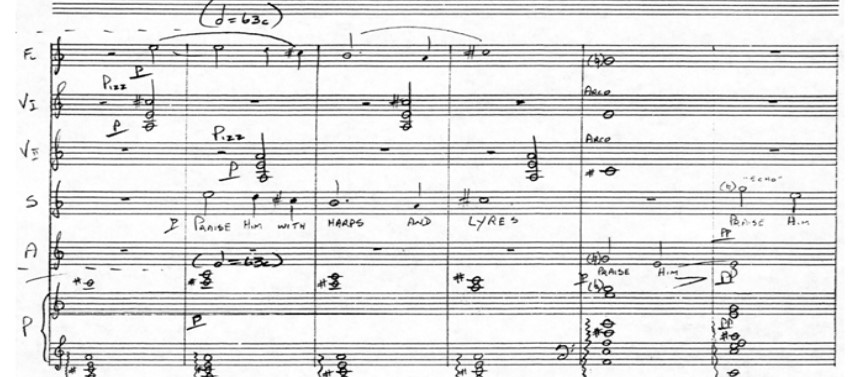MU student Jack Lenihan writes about John Kinsella
MU student Jack Lenihan recently spent five weeks in CMC Library, digitising some of the works of John Kinsella as part of his studies towards an MA in Musicology in Maynooth University. Here he writes about his experience and the works he digitised.
My name is Jack Lenihan and I am a Masters student of Maynooth University currently pursuing an MA in Musicology. As part of a research and skills module, I had the pleasure of spending five weeks at the Contemporary Music Centre of Ireland where I researched and digitised musical scores by the great Irish composer, John Kinsella (b.1932).
As a recipient of the National Concert Hall Lifetime Achievement Award at the relatively recent premiere of his 11th Symphony in November 2019, John Kinsella is not only one of the most accomplished Irish composers today but is renowned as Ireland’s most prolific symphonists. Kinsella’s career also consisted of notable musical roles such as Head of Music at RTÉ (1983-1988) whilst also producing an impressive catalogue of choral works, concertos, string quartets and symphonies. His predilection with contemporary European avant-garde music proved to be an integral part of Kinsella’s early compositional voice work which was gradually manipulated over time through tonal adoptions of modernist ‘row’ ideas. Such is his enormous contribution to contemporary Irish music that many of his compositions have been commissioned by The Irish Chamber Orchestra, RTÉ National Symphony Orchestra, Dublin International Piano Competition and The Arts Council of Wales. Unsurprisingly, much of Kinsella’s work has been accounted for and digitised at the Contemporary Music Centre with the exception of a handful of lesser-known, non-symphonic works which I had the privilege to digitise.
Amongst these works were Allegro Giocoso (1966) and Dawn (1986) and Praise the Lord (1995). Amidst my research, I noticed features in these works that effectively mirrored Kinsella’s charismatic compositional style that is embedded into his larger symphonic works.
One such work was Dawn (1986), a choral SATB work that was commissioned for the 22nd Seminar on Contemporary Choral Music held in University College Cork in 1986. Through reflecting on the score, I was intrigued by the way in which the composer applied contemporary avant-garde approaches to this work considering that Kinsella avoided explicit use of such ideas from this musical movement after the 1960s. As a setting to the poem Dawn, by Irish nationalist poet, Francis Ledwidge, Kinsella provides a modernist sophistication to a sentimental poem that yearns for the traditional Irish landscape.
In observing the harmonic implications of the work, I noticed the frequent alteration between the notes F# and F natural despite the fact that the apparent key is in F major. While there are certain evocations of bitonality throughout the work, the close relationship between these notes as well as the chords F# major and F natural major is palpable especially when one considers that opening chord is the former and the closing chord the latter.
The above bars of 41-42, specifically in the tenor line, also portray the adjacency of the notes F sharp and F natural despite the prevailing harmonic chord of F major 7 in this instance. Interestingly, scholar Séamus de Barra has contributed a similar assertion of this peculiar aspect in Kinsella’s compositional style in his dissertation The Symphonies of John Kinsella (2013). In his analysis of theme 3 in Kinsella’s Symphony no. 6, de Barra notes:
The prominent alternation of F sharps and F naturals is a very distinctive feature of this idea, and it recalls (unusually in Kinsella’s work) the contours of Irish folk music, particularly that of the sean-nós or old-style song repertoire. (p.271)
One also may interpret the bitonality and close relationship between these notes separated by semitones as a harmonic advancement of sean-nós melodies by Kinsella. The microtonal evocations of sean-nós melodies imply semi-tonal movement that Kinsella develops both melodically and harmonically in this work.
Another work that similarly revealed implications of Kinsella’s symphonic style was the psalm Praise the Lord. As a choral chamber work, it was commissioned for the formal opening of the restored Gothic Cathedral at Kylemore Abbey in Connemara, Galway. Kinsella’s orchestral mastery is palpable in this joyous work and while there are no coherent harmonic implications of contemporary avant-garde complexity, I found there to be especially meaningful use of pizzicato chords. Throughout the work, Kinsella employs pizzicato in the first and second violins as a rhythmic device and one instance of this technique is evident in bars 73-76.
In the above musical example, the rhythmic structure is clearly outlined through the piano and pizzicato chords and moreover, the significant lyrics ‘praise him’ are both emphasised by these instruments in bar 74. As de Barra has observed in his analysis of the B1 section of Kinsella’s Symphony no.10 (2012), the use of ‘Stravinsky-like pizzicato’ (p. 348) as a salient feature is asserted and thus, it is also in Praise the Lord. Stravinsky’s percussive treatment of pizzicato chords not only compliments the harmony but provides a leaner tone that aptly emphasises the praising of ‘him’ (God). The implicit presence of Stravinsky’s influence in Praise the Lord highlights how Kinsella still achieves to accentuate modernist ideas in an almost strictly tonal, non-secular work.
Similarly in a much earlier work of Kinsella’s I digitised, Allegro Giocoso (1966), the composer subtly applies contemporary fragmented melodic designs. As the work was composed for solo harp, there is an evocation of delicate intimacy that is not only suggested through its gracious tonality of Eb major but also through subdued melodies and dynamics such as ‘prés de la table’. A notably recent performance of this work took place at the Russian-Irish Music Festival in the Moscow Kremlin in 2017 which was rendered by Russian harp soloist Nika Riabchinenko.
In the documentary series Cross Currents, produced by Athena Media in association with the Contemporary Music Centre and RTÉ lyric fm, an episode featuring John Kinsella offers a similar insight into his compositional intentions when incorporating influences of iconic modern European Composers. Upon discussing his expansion of rhythmic and thematic figures from Sibelius’ compositional sketches, Kinsella equates his actions to that of ‘touching the garment of a prophet’.
‘Touching the garment of a prophet’ – Kinsella
I believe this metaphor aptly captures Kinsella’s unique ability to shape and preserve contemporary European avant-garde influences whilst also maintaining a respect for composers such as Sibelius and Stravinsky.
Reflecting upon the musical merits of these works, I believe that there are traces of Kinsella’s compositional idiosyncrasies that reveal the composer’s continuation of modernist European ideas such as the Stravinsky-like application of pizzicato in Praise the Lord as well as his fondness of traditional Irish music subtleties such as the semi-tonal presence in Dawn. Therefore, the necessary investigation of similar analysis of such prolific composer’s less renowned works bear tremendous significance and nonetheless so in relation to the musical works by John Kinsella addressed in this article. Although these works represent a mere snippet of Kinsella’s elusive compositional style, the plethora of the composer’s work that has been digitised warrants further investigation and analysis that will prove enlightening.
I thoroughly enjoyed my work experience at the Contemporary Music Centre. Through digitising, I was afforded the opportunity to discover these intriguing works by Kinsella and explore the various musical nuances of Kinsella’s style that ranged from 1966 (Allegro Giocoso) to 1995 (Praise the Lord). I am very grateful to the essential guidance and assistance of the staff of the Contemporary Music Centre, namely Susan Brodigan and Keith Fennell who helped make this research possible.




